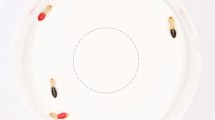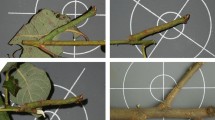Abstract
LINDROTH1 suggests that some insects gain a selective advantage by mimicking other insects whose striking colour patterns serve to warn potential predators of an unusually effective escape mechanism. The mimicked insects hop suddenly when disturbed, greatly lessening the probability of a predator's success. A learning predator comes to associate particular colour patterns with wasted effort and spurns both the model and the relatively sluggish mimic, so long as encounters with the model substantially outnumber those with the mimic. Lindroth's hypothesis may help explain cases of apparently aposematic (warning) coloration in non-mimetic animals which are neither poisonous, distasteful, nor formidably outfitted for defence, but which possess efficient close quarter escape mechanisms2. I propose that the phenomenon of escape warning coloration may be an important factor in the colour polymorphism of Philaenus spumarius (L.), the common meadow spittlebug.
This is a preview of subscription content, access via your institution
Access options
Subscribe to this journal
Receive 51 print issues and online access
$199.00 per year
only $3.90 per issue
Buy this article
- Purchase on Springer Link
- Instant access to full article PDF
Prices may be subject to local taxes which are calculated during checkout
Similar content being viewed by others
References
Lindroth, C. H., Entomol. Scand., 2, 41 (1972).
Nature, 235, 312 (1972).
Thompson, V., and Halkka, O., Amer. Midland Naturalist (in the press).
Owen, D. F., and Wiegert, R. G., Amer. Naturalist, 96, 353 (1962).
Owen, D. F., Nature, 198, 201 (1963).
Halkka, O., Raatikainen, M., Halkka, L., and Lallukka, R., Ann. Zool. Fennici, 7, 221 (1970).
Clarke, B., Systematics Association Publication No. 4, 47 (1962).
Cott, H. B., Adaptive Coloration in Animals (Methuen, London, 1940).
Weaver, C. R., and King, D. R., Ohio Agr. Expt. Sta. Res. Bull., Wooster, 741, 1 (1954).
Wiegert, R. G., Ecol. Monographs, 34, 217 (1964).
Robertson, A., and Gibbs, A. J., J. Trop. Med. Hyg., 40, 257 (1937).
Garman, P., Conn. Agr. Expt. Sta. Bull., 230, 327 (1921).
Author information
Authors and Affiliations
Rights and permissions
About this article
Cite this article
THOMPSON, V. Spittlebug Polymorphic for Warning Coloration. Nature 242, 126–128 (1973). https://doi.org/10.1038/242126a0
Received:
Issue Date:
DOI: https://doi.org/10.1038/242126a0
This article is cited by
-
Philaenus spumarius: when an old acquaintance becomes a new threat to European agriculture
Journal of Pest Science (2018)
-
Polymorphism under apostatic and aposematic selection
Heredity (1984)
-
Clines in the colour polymorphism of Philaenus spumarius in Eastern Central Europe
Heredity (1975)
-
Spittlebug morph mimics avian excrement
Nature (1974)
-
Batesian mimicry without distastefulness?
Nature (1974)
Comments
By submitting a comment you agree to abide by our Terms and Community Guidelines. If you find something abusive or that does not comply with our terms or guidelines please flag it as inappropriate.



